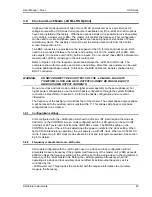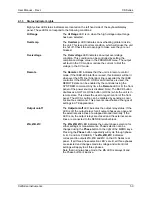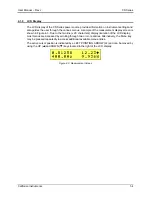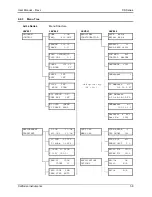
User Manual – Rev J
CS Series
California Instruments
45
3.9
Clock and Lock Mode (-LKM/-LKS Option)
Clock and lock mode operation of two or more CS AC power sources or a Lx/Ls Series AC
voltage source with a CS Series Current source is available only if the –LKM and –LKS options
have been installed at the factory. With these options installed, it is possible to lock an auxiliary
unit (-LKS) to a master unit (-LKM). The master unit controls the frequency. This configuration
can be used to create multiphase power systems such as split-phase or six phases or Power
simulation systems. The auxiliary unit must be set to external clock mode from the Control
screen. See section 4.2.5.
Two BNC connectors are provided on the rear panel of the CS for clock and lock mode. Both
need to be connected between the master and auxiliary unit. On the master unit (-LKM), both
are outputs. On the slave unit (-LKS), both are inputs. Do not connect these BNC’s between two
master units (-LKM’s) or damage to the unit could result.
Refer to Figure 3-8 for the required connections between the –LKM and –LKS units. The
example is shown for two units, one master, one auxiliary. More than one auxiliary can be used
to create additional phase outputs. In this case, the BNC cables can be daisy chained using
BNC T connectors.
WARNING:
DO NOT CONNECT THE AC OUTPUTS OF THE –LKM AND –LKS UNITS
TOGETHER. CLOCK AND LOCK OUTPUTS CANNOT BE PARALLELED TO
OBTAIN HIGHER OUTPUT CURRENTS.
Do not use clock and lock mode to obtain higher power capability on the same phase(s). For
higher power configurations, use the multi-chassis configuration through the system interface
connection instead. Refer to section 3.5.3 for multi-chassis configuration and connection
information.
The frequency of the auxiliary unit will track that of the master. The output phase angle of phase
A will be locked to the auxiliary unit as well to within 3°. This allows split phase or six phase
configurations to be created.
3.9.1 Configuration
settings
Units configured with the –LKM option will show the Clock as INT (internal) and the mode as
CLK/LOC on the CONTROL screen. Units configured with the –LKS option can be set to INT
(internal) or EXT (external) clock from the CONTROL screen. The MODE setting on the
CONTROL screen of the –LKS unit determines the power on state for the clock setting. When
set to STAN (Stand-alone operation), the unit powers up with INT clock. When set to CLK/LOC
mode, it powers up in EXT clock mode suitable to clock and lock system operation. See section
4.2.5 for details.
3.9.2
Frequency measurements on –LKS units
CS models configured with the –LKS option used in a clock and lock configuration will not
accurately measure frequency if the programmed frequency of the master unit (-LKM) exceeds
2000 Hz unless the frequency setting of the –LKS is set to the a value close to the programmed
frequency of the –LKM master unit. Setting the –LKS programmed frequency when it is
operating as a clock and lock auxiliary does not affect its actual output frequency as it is
controlled by the
–LKM master unit. This provides the controller with the required information to accurately
measure the frequency.
Содержание 13500CS/3
Страница 5: ...User Manual Rev J CS Series California Instruments 5 SAFETY SYMBOLS ...
Страница 34: ...User Manual Rev J CS Series California Instruments 34 Figure 3 3 9000CS 2 Wiring diagram 3 Phase mode ...
Страница 35: ...User Manual Rev J CS Series California Instruments 35 Figure 3 4 13500CS 3 Wiring diagram 3 Phase mode ...
Страница 36: ...User Manual Rev J CS Series California Instruments 36 Figure 3 5 18000CS 4 Wiring diagram 3 Phase mode ...
Страница 56: ...User Manual Rev J CS Series California Instruments 56 The power source is now ready to be used ...
Страница 73: ...User Manual Rev J CS Series California Instruments 73 ...
Страница 111: ...User Manual Rev J CS Series CS Series 111 voltage rating 28 W Weight 22 Wiring AC input 30 ...




































